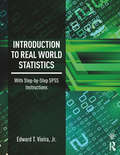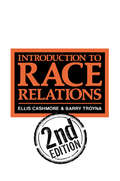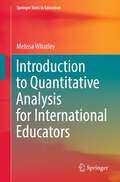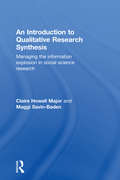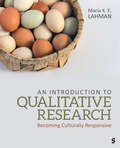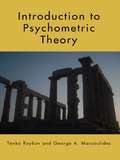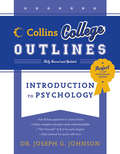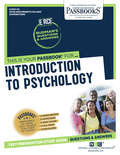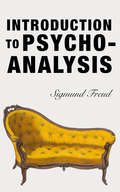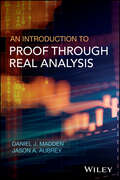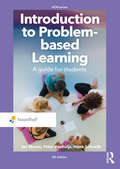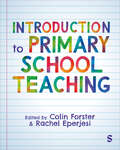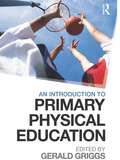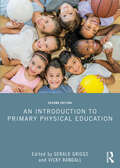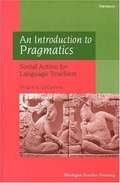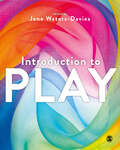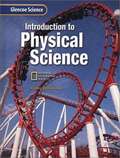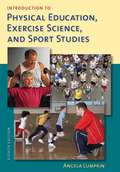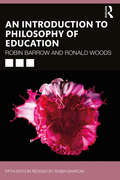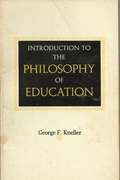- Table View
- List View
Introduction to Real World Statistics: With Step-By-Step SPSS Instructions
by Edward T. Vieira Jr.Introduction to Real World Statistics provides students with the basic concepts and practices of applied statistics, including data management and preparation; an introduction to the concept of probability; data screening and descriptive statistics; various inferential analysis techniques; and a series of exercises that are designed to integrate core statistical concepts. The author’s systematic approach, which assumes no prior knowledge of the subject, equips student practitioners with a fundamental understanding of applied statistics that can be deployed across a wide variety of disciplines and professions. Notable features include: short, digestible chapters that build and integrate statistical skills with real-world applications, demonstrating the flexible usage of statistics for evidence-based decision-making statistical procedures presented in a practical context with less emphasis on technical jargon early chapters that build a foundation before presenting statistical procedures SPSS step-by-step detailed instructions designed to reinforce student understanding real world exercises complete with answers chapter PowerPoints and test banks for instructors.
Introduction To Race Relations
by Barry TroynaThis is the second edition of the textbook on race and ethnic relations, which has been adopted by academic and vocational courses and which is designed to be a straightforward introduction to this field of study. It retains all the original features, but reflects on events over the years since its original publication, incorporating accounts of developments in the UK and USA. Suggestions for further readings are revised in the light of the latest research.
Introduction to Quantitative Analysis for International Educators (Springer Texts in Education)
by Melissa WhatleyThis textbook introduces international education scholars, professionals and graduate students to quantitative research methods. It provides them with the most foundational and useful concepts in quantitative analysis, using international education themes for all examples and practice problems. Readers will have a foundation to pursue more advanced methods and analyses, whether through formal training or future individual study.The book assumes no prior knowledge of quantitative analysis and is written for individuals who are new to statistics. Practice problems are found at the end of all substantive chapters, and datasets are provided so that readers can practice the analyses that are presented. Moreover, in each chapter, different statistical approaches are illustrated with real examples from international education research. These examples provide context for each statistical method and represent a wide variety of contexts in international education research, covering a variety of international education topics and a variety of regions of the world. From the instructor perspective, these example studies could be used as additional course reading. Moreover, supplemental material provides slides that instructors can modify and use in conjunction with the text.
An Introduction to Qualitative Research Synthesis: Managing the Information Explosion in Social Science Research
by Claire Howell Major Maggi Savin-BadenProviding a comprehensive guide for understanding, interpreting and synthesizing qualitative studies, An Introduction to Qualitative Research Synthesis shows how data can be collated together effectively to summarise existing bodies of knowledge and to create a more complete picture of findings across different studies The authors describe qualitative research synthesis and argue for its use, describing the process of data analysis, synthesis and interpretation and provide specific details and examples of how the approach works in practice. This accessible book: fully explains the qualitative research synthesis approach; provides advice and examples of findings; describes the process of establishing credibility in the research process; provides annotated examples of the work in process; references published examples of the approach across a wide variety of fields. Helping researchers to understand, make meaning and synthesize a wide variety of datasets, this book is broad in scope yet practical in approach. It will be beneficial to those working in social science disciplines, including researchers, teachers, students and policy makers, especially those interested in methods of synthesis such as meta-ethnography, qualitative meta-analysis, qualitative meta-synthesis, interpretive synthesis, narrative synthesis, and qualitative systematic review.
An Introduction to Qualitative Research: Becoming Culturally Responsive
by Maria K. LahmanThis engaging introduction to all aspects of qualitative research challenges students to consider how their research can be culturally responsive. The first part of the book introduces the foundations including theory, ethics, and reflexivity, with an emphasis on multiple methodologies, from traditional to critical and cutting-edge. The second part covers practical guidance from writing proposals to data collection, and includes a chapter dedicated to creating a culturally responsive relationship with research participants. Finally, readers engage with how the quality of research is enhanced, how data are analyzed, and how research accounts are created and disseminated. Areas vital to the health of qualitative research are addressed including systemic racism and cultural humility, with cutting-edge suggestions offered in areas like hybrid research, harnessing technology, and use of social media. Multiple identities are centered in examples throughout including race, gender, and those who are hard to reach or seldom heard in research. Textboxes featuring scholars, student researchers, and community members invite readers into dialogue in an area that is contested, swiftly shifting, and always vibrant with potential. Resources for instructors are available on a website to accompany the book at: https://edge.sagepub.com/lahman
An Introduction to Qualitative Research: Becoming Culturally Responsive
by Maria K. LahmanThis engaging introduction to all aspects of qualitative research challenges students to consider how their research can be culturally responsive. The first part of the book introduces the foundations including theory, ethics, and reflexivity, with an emphasis on multiple methodologies, from traditional to critical and cutting-edge. The second part covers practical guidance from writing proposals to data collection, and includes a chapter dedicated to creating a culturally responsive relationship with research participants. Finally, readers engage with how the quality of research is enhanced, how data are analyzed, and how research accounts are created and disseminated. Areas vital to the health of qualitative research are addressed including systemic racism and cultural humility, with cutting-edge suggestions offered in areas like hybrid research, harnessing technology, and use of social media. Multiple identities are centered in examples throughout including race, gender, and those who are hard to reach or seldom heard in research. Textboxes featuring scholars, student researchers, and community members invite readers into dialogue in an area that is contested, swiftly shifting, and always vibrant with potential. Resources for instructors are available on a website to accompany the book at: https://edge.sagepub.com/lahman
Introduction to Psychometric Theory
by George A. Marcoulides Tenko RaykovThis new text provides a state-of the-art introduction to educational and psychological testing and measurement theory that reflects many intellectual developments of the past two decades. The book introduces psychometric theory using a latent variable modeling (LVM) framework and emphasizes interval estimation throughout, so as to better prepare readers for studying more advanced topics later in their careers. Featuring numerous examples, it presents an applied approach to conducting testing and measurement in the behavioral, social, and educational sciences. Readers will find numerous tips on how to use test theory in today's actual testing situations. To reflect the growing use of statistical software in psychometrics, the authors introduce the use of Mplus after the first few chapters. IBM SPSS, SAS, and R are also featured in several chapters. Software codes and associated outputs are reviewed throughout to enhance comprehension. Essentially all of the data used in the book are available on the website. In addition instructors will find helpful PowerPoint lecture slides and questions and problems for each chapter. The authors rely on LVM when discussing fundamental concepts such as exploratory and confirmatory factor analysis, test theory, generalizability theory, reliability and validity, interval estimation, nonlinear factor analysis, generalized linear modeling, and item response theory. The varied applications make this book a valuable tool for those in the behavioral, social, educational, and biomedical disciplines, as well as in business, economics, and marketing. A brief introduction to R is also provided. Intended as a text for advanced undergraduate and/or graduate courses in psychometrics, testing and measurement, measurement theory, psychological testing, and/or educational and/or psychological measurement taught in departments of psychology, education, human development, epidemiology, business, and marketing, it will also appeal to researchers in these disciplines. Prerequisites include an introduction to statistics with exposure to regression analysis and ANOVA. Familiarity with SPSS, SAS, STATA, or R is also beneficial. As a whole, the book provides an invaluable introduction to measurement and test theory to those with limited or no familiarity with the mathematical and statistical procedures involved in measurement and testing.
Introduction to Psychology
by Joseph Johnson Ann L. WeberMaster Your Coursework with Collins College Outlines The Collins College Outline for Introduion to Psychology provides students with a detailed overview of basic psychology coursework. This book covers research methods, behavior, perception, cognition, human development, personality, intelligence, psychological disorders, and much more. Completely revised and updated by Dr. Joseph Johnson, this book includes a test yourself seion with answers and complete explanations at the end of each chaper. Also included are bibliographies for further reading, as well as numerous graphs, charts, and illustrations. The Collins College Outlines are a completely revised, in-depth series of study guides for all areas of study, including the Humanities, Social Sciences, Mathematics, Science, Language, History, and Business. Featuring the most up-to-date information, each book is written by a seasoned professor in the field and focuses on a simplified and general overview of the subje for college students and, where appropriate, Advanced Placement students. Each Collins College Outline is fully integrated with the major curriculum for its subje and is a perfe supplement for any standard textbook.
Introduction to Psychology
by Mcdougal LittellSome of the topics covered in this book include: the world of psychology, research in psychology, psychology & the brain, sensation, perception, consciousness, learning, memory and intelligence among others.
Introduction to Psychology: Passbooks Study Guide (Excelsior/Regents College Examination Series)
by National Learning CorporationThe Excelsior/Regents College Examinations (E/RCE) offer you an opportunity to obtain recognition for college-level learning and consists of exams designed to demonstrate achievement and mastery of various college-level subjects, such as the Arts and Sciences, Business, Criminal Justice, Education, Health and Nursing. The E/RCE Introduction to Psychology Passbook® prepares you by sharpening knowledge of the skills and concepts necessary to succeed on the upcoming exam and the college courses that follow. It provides a series of informational texts as well as hundreds of questions and answers in the areas that will likely be covered on your upcoming exam.
Introduction to Psychoanalysis: A History Of Psychoanalytic Theory, Treatment And Therapy (hardcover) (World Literature Ser.)
by Sigmund FreudOriginally a set of lectures given by Sigmund Freud 1915-1917, Introduction to Psychoanalysis is now not only widely translated and popular, but also culturally significant. The 28 lectures offer Freud&’s views of the unconscious and the basis of psychoanalysis as we know it today. These conversational-style lectures are broken into three parts, beginning with Freudian slips, moving to dream theory, and then neuroses, and in them Freud successfully presents his ideas as firmly grounded in the everyday experience.
An Introduction to Proof through Real Analysis
by Daniel J. Madden Jason A. AubreyAn engaging and accessible introduction to mathematical proof incorporating ideas from real analysis A mathematical proof is an inferential argument for a mathematical statement. Since the time of the ancient Greek mathematicians, the proof has been a cornerstone of the science of mathematics. The goal of this book is to help students learn to follow and understand the function and structure of mathematical proof and to produce proofs of their own. An Introduction to Proof through Real Analysis is based on course material developed and refined over thirty years by Professor Daniel J. Madden and was designed to function as a complete text for both first proofs and first analysis courses. Written in an engaging and accessible narrative style, this book systematically covers the basic techniques of proof writing, beginning with real numbers and progressing to logic, set theory, topology, and continuity. The book proceeds from natural numbers to rational numbers in a familiar way, and justifies the need for a rigorous definition of real numbers. The mathematical climax of the story it tells is the Intermediate Value Theorem, which justifies the notion that the real numbers are sufficient for solving all geometric problems. • Concentrates solely on designing proofs by placing instruction on proof writing on top of discussions of specific mathematical subjects • Departs from traditional guides to proofs by incorporating elements of both real analysis and algebraic representation • Written in an engaging narrative style to tell the story of proof and its meaning, function, and construction • Uses a particular mathematical idea as the focus of each type of proof presented • Developed from material that has been class-tested and fine-tuned over thirty years in university introductory courses An Introduction to Proof through Real Analysis is the ideal introductory text to proofs for second and third-year undergraduate mathematics students, especially those who have completed a calculus sequence, students learning real analysis for the first time, and those learning proofs for the first time. Daniel J. Madden, PhD, is an Associate Professor of Mathematics at The University of Arizona, Tucson, Arizona, USA. He has taught a junior level course introducing students to the idea of a rigorous proof based on real analysis almost every semester since 1990. Dr. Madden is the winner of the 2015 Southwest Section of the Mathematical Association of America Distinguished Teacher Award. Jason A. Aubrey, PhD, is Assistant Professor of Mathematics and Director, Mathematics Center of the University of Arizona.
Introduction to Problem-Based Learning (Routledge-Noordhoff International Editions)
by Jos Moust Peter Bouhuijs Henk SchmidtIntroduction to Problem-based Learning teaches students how to work with the problem-based learning method, which requires mainly self-directed learning. Particular attention is given to the necessary skills to apply this method effectively. Why Introduction to Problem-based Llearning? • comprehensible introduction in the problem-based learning method • enables students to experience the full potential of this concept • discusses the use of digital devices Introduction to Problem-based learning provides students with the necessary skills to operate within as well as outside problem-based groups. It discusses issues like: How do you take on a problem? How do you collaborate with others? How do you deal with cultural diversity? How do you lead a tutorial group? How can you organize your studies best? Special attention is given to the use of computers, tablets and internet in a problem-based environment.
Introduction to Primary School Teaching
by Colin Forster Rachel EperjesiThis book gives primary student teachers the professional knowledge required to succeed in the classroom and an understanding of how to develop their teaching skills throughout their teacher training course. Taking the key themes of the ITT Core Content Framework, this comprehensive book covers every major aspect of contemporary teaching and supports new teachers in reflecting on what good pedagogic practice looks like and how to develop this through observing and learning from expert colleagues. Case studies, based on real examples provided by headteachers and other experts, offer the chance to explore day-to-day teaching issues in real life. Critical tasks and question guides challenge readers to deepen their practical knowledge. This is essential reading for all students on primary initial teacher education courses including university-based (PGCE, BEd, BA with QTS) and school-based (School Direct, SCITT, Teach First) routes into teaching.
Introduction to Primary School Teaching
by Colin Forster Rachel EperjesiThis book gives primary student teachers the professional knowledge required to succeed in the classroom and an understanding of how to develop their teaching skills throughout their teacher training course. Taking the key themes of the ITT Core Content Framework, this comprehensive book covers every major aspect of contemporary teaching and supports new teachers in reflecting on what good pedagogic practice looks like and how to develop this through observing and learning from expert colleagues. Case studies, based on real examples provided by headteachers and other experts, offer the chance to explore day-to-day teaching issues in real life. Critical tasks and question guides challenge readers to deepen their practical knowledge. This is essential reading for all students on primary initial teacher education courses including university-based (PGCE, BEd, BA with QTS) and school-based (School Direct, SCITT, Teach First) routes into teaching.
An Introduction to Primary Physical Education
by Gerald GriggsPhysical Education is a core component of the primary school curriculum. The primary years are perhaps the most significant period for motor development in children, a time during which basic movement competencies are developed and which offers the first opportunity for embedding physical activity as part of a healthy lifestyle. This is the first comprehensive introduction to the teaching of PE in the primary school to be written exclusively by primary PE specialists, with primary school teaching experience. The book highlights the importance of PE in the primary curriculum and the key issues facing primary teachers today, such as inclusion, training needs and the development of creativity. Central to the book are core chapters that examine each functional area common to many primary PE syllabi – including games, dance, gymnastics, athletics and outdoor learning – and give clear, practical guidance on how to teach each topic. Rooted throughout in sound theory and the latest evidence and research, this book is essential reading for all students, trainee teachers and qualified teachers looking to understand and develop their professional practice in primary Physical Education.
An Introduction to Primary Physical Education
by Gerald Griggs Vicky RandallNow in a fully revised and fully updated new edition, this comprehensive introduction to the teaching of Physical Education in primary schools is still the only textbook to cover the full sweep of the subject, from policy and curriculum developments to best practice and current debates. Written exclusively by primary Physical Education specialists, with primary school teaching experience, the book highlights the importance of Physical Education in the primary curriculum and the key issues facing primary teachers today, such as inclusion, training needs and the development of creativity. Central to the book are core chapters that examine each functional area common to many primary Physical Education syllabi – including games, dance, gymnastics, athletics and outdoor learning – and give clear, practical guidance on how to teach each topic. This new edition includes three completely new chapters, covering leadership, stakeholder interest in Physical Education delivery, and how to manage transitions. Rooted throughout in sound theory and the latest evidence and research, this book is essential reading for all students, trainee teachers and qualified teachers looking to understand and develop their professional practice in primary Physical Education.
An Introduction to Pragmatics: Social Action for Language Teachers
by Virginia LocastroAn Introduction to Pragmatics is designed for use in introductory courses in pragmatics (both undergraduate and graduate level) for students preparing to teach. By including the perspective of ESL and EFL educators, this book provides prospective teachers with an understanding of pragmatics that will help them: integrate the teaching of pragmatic competence in language programs and materials understand the problems learners have with comprehension of messages requiring cognitive processing beyond that of the spoken or written word evaluate textbooks and materials as well as assessment procedures for language proficiency assess the value of communicative language teaching practices assist learners in developing strategies to handle misunderstandings and other communication problems expand knowledge of how language is used in the world by people in everyday situations, including classrooms.
Introduction to Play
by Jane Waters-DaviesThe go-to textbook for everything you need to know about play! Covering ages 0-8, this book explores what play is, why it matters and where and how play happens. Taking you from start to finish on your course, it helps you: Think critically about play and play provision Understand what good practice looks like See how theory translates into real-world settings Explore the issues, debates, and challenges within play and early learning
Introduction to Play
by Jane Waters-DaviesThe go-to textbook for everything you need to know about play! Covering ages 0-8, this book explores what play is, why it matters and where and how play happens. Taking you from start to finish on your course, it helps you: Think critically about play and play provision Understand what good practice looks like See how theory translates into real-world settings Explore the issues, debates, and challenges within play and early learning
Introduction to Physical Science
by McGraw-HillA book helping students to understand concepts of physical science.
Introduction to Physical Education, Exercise Science, and Sport Studies (Eighth Edition)
by Angela LumpkinThe intent of this book is to broaden students' understanding of how the philosophies and programs of physical education, exercise science, and sport evolved as well as to present the current status of these fields.
Introduction to Photography: A Visual Guide to the Essential Skills of Photography and Lightroom
by Mark GalerThis book is intended to be the primary textbook to support any college who would like to run a Photography 101 course for students. The course is designed to offer tutors an independent learning tool to enable students to learn the craft of using an interchangeable lens camera (DSLR or Mirrorless) and the basics of an image-editing program (Adobe Lightroom) to enable them to take creative control of the imaging process. The curriculum offers a step-by-step and jargon-free approach to learning the fundamental skills of creative camera control. Each page features a large image with a brief explanation of how the creative controls of the camera have led to the resulting visual appearance of the image. Information on each page is stripped down the essentials and text is carefully selected to be unambiguous and kept to the bare minimum to ensure rapid acquisition of the skills on offer. This effective course-in-a-book allows students quickly to become technically proficient, and instructors to efficiently evaluate students' progress.
An Introduction to Philosophy of Education
by Robin Barrow Ronald WoodsThis introductory text, now in its fifth edition, is a classic in its field. It shows, first and foremost, the importance of philosophy in educational debate and as a background to any practical activity such as teaching. What is involved in the idea of educating a person or the idea of educational success? What are the criteria for establishing the optimum balance between formal and informal teaching techniques? How trustworthy is educational research? In addition to these questions, which strike to the heart of the rationale for the educative process as a whole, the authors explore such concepts as culture, creativity, autonomy, indoctrination, needs, interests, and learning by discovery. Updates to this edition include new chapters on religious education and moral education, as well as questions for reflection at the end of each chapter.
Introduction To The Philosophy Of Education
by E. KnellerThe purpose of this book is to outline those elements of philosophy that are relevant to a proper understanding of education and the task of teaching. Much of the content comes from a text that I edited, entitled Foundations of Education (Wiley, 1963). I have rewritten and in places enlarged the original, especially the sections on existentialism and logical analysis, which I have assigned to a separate chapter.
